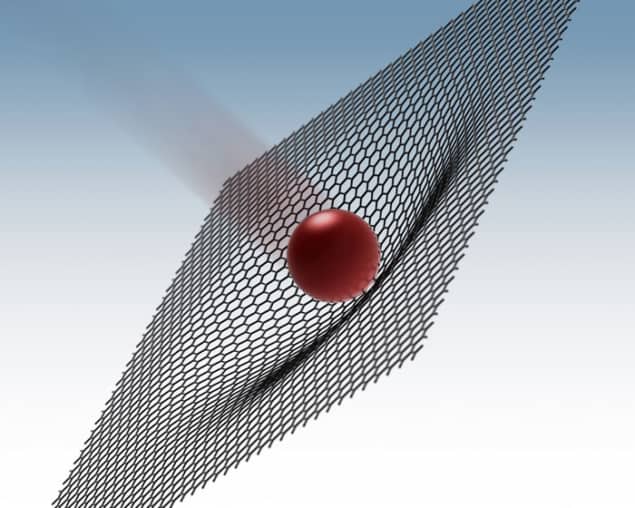
Graphene sheets are 8 to 10 times better than steel when it comes to absorbing impacts from supersonic “microbullets”. That is the conclusion of researchers in the US, who have fired tiny silica spheres at the carbon material and compared the kinetic energy of the spheres before and after they had penetrated the sheets. The result implies that graphene might be ideal for making bullet-proof vests, among other applications, and the technique employed in these experiments could be used to test the strength and toughness of other nanomaterials as well.
The “wonder material” graphene – sheets of carbon just one atom thick – is thought to be the strongest material in the world, thanks to its 2D hexagonal lattice of covalently bonded carbon atoms. Indeed, researchers recently measured its in-plane Young’s modulus – a measure of how well it resists deformation – to be more than 1 TPa, which is nearly that of diamond. Although such experiments provide valuable information on a material’s mechanical properties, they are essentially low-speed tests with impacts occurring at less than 1 m s–1. As a result, they cannot measure deformations that happen very fast, which is the case in ballistic impacts, where projectile velocities can be 1000 times faster. Although high-speed, high-strain-rate mechanical characterization techniques do exist, these methods are inappropriate for very thin layers of material.
Laser-based testing
A team led by Edwin Thomas of Rice University recently came up with a new technique called laser-induced projectile impact testing (LIPIT), and has now improved on this to test the strength of graphene. LIPIT sees the researchers fire a single micron-sized solid silica sphere travelling at speeds of nearly 3 km s–1 into a carbon sheet and measuring the velocity of the microbullet before and after it has penetrated the material. This allows them to calculate the kinetic energy of the bullet lost during the test. The experiments are performed on multilayer graphene membranes ranging in thickness from 10 to 100 nm – which is equivalent to 30 to 300 graphene layers – and the technique allows a tiny part of the sample to be strained, or deformed, at very high rates.
The researchers used multilayer graphene samples that were shaved off blocks of graphite. They were able to fire their microbullets at supersonic speeds using a laser pulse. “Instead of gunpowder, we vaporize a thin (50 nm) gold film using a focused laser beam, and it is the resulting expanding gold gas that accelerates the microbullet,” explains team member, Jae-Hwang Lee.
After analysing microscope images of the impacts, the researchers discovered that graphene dissipates the kinetic energy from the microbullet by first stretching into a cone shape at the impact site and then cracking along its crystallographic directions. These cracks extend outwards, well beyond the impact area, says Lee.
Efficient energy dissipation
“When a microbullet penetrates a thin target material, it dissipates the kinetic energy of the projectile by transferring this energy back to itself,” Lee says. “Graphene can dissipate this energy very efficiently, which makes it better than other materials (even steel).”
The result means that graphene might be ideal for making bullet-proof vests and other types of armour, he says. “It might even be used in futuristic applications such as coatings for satellites and the International Space Station that protect against micrometeorites,” he adds.
The researchers claim that their micro-ballistic technique could also be a unique way to study the mechanical behaviour of various other nanostructured materials.
The team, which includes researchers from the University of Massachusetts Amherst, is now busy trying out its miniaturized ballistic test on various other graphene systems. These include graphene composites and graphene with engineered defects, which is expected to be weaker than pristine graphene.
The work is described in Science.
- This article first appeared on nanotechweb.org


